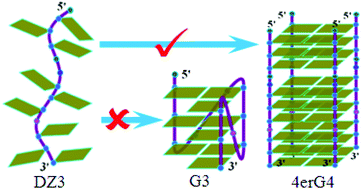Characterization of intermolecular G-quadruplex formation over intramolecular G-triplex for DNA containing three G-tracts†
Abstract
G-triplex (G3) has been recognized as a popular intermediate during the folding of G-quadruplex (G4). This has raised interest to anticipate the ultimate formation of G3 by shortening the G4-forming oligonucleotides with the remaining three G-tracts. Some G3 structures have been validated and their stability has been found to be affected by the loop sequences similar to G4s. In this work, however, we first found that an intermolecular parallel G4 structure was preferred in K+ for the oligonucleotide 5′-TGGGTAGGGCGGG-3′ (DZ3) containing only three G-tracts. We screened auramine O (AO) as the appropriate fluorophore with a molecular rotor feature to target this G4 structure. AO bound with DZ3 in a 1 : 4 ratio, as confirmed by isothermal titration calorimetry experiments, suggesting the formation of a tetramolecular G4 structure (4erG4). The excimer emission from the labelled pyrene and the DNA melting behavior at various pHs in the presence of Ag+ proved the formation of the 4erG4 structure rather than the prevalent intramolecular G3 folding. This work demonstrates that one should be cautious while putatively predicting a G3 structure from an oligonucleotide containing three G-tracts.



 Please wait while we load your content...
Please wait while we load your content...